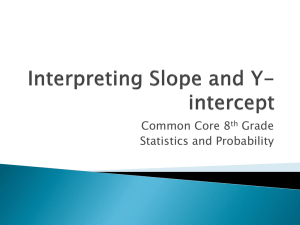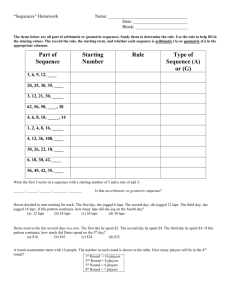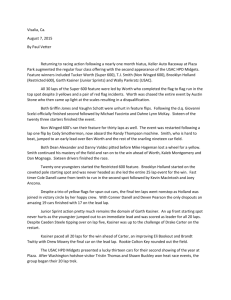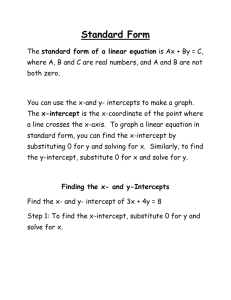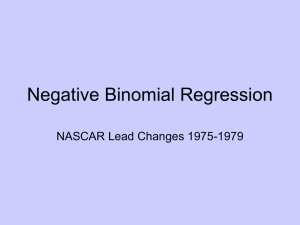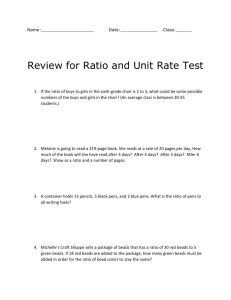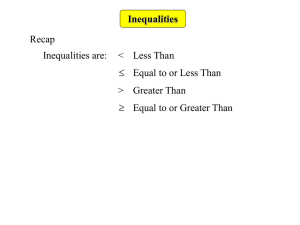Lesson Study Plan - Center for Outreach in Mathematics
advertisement
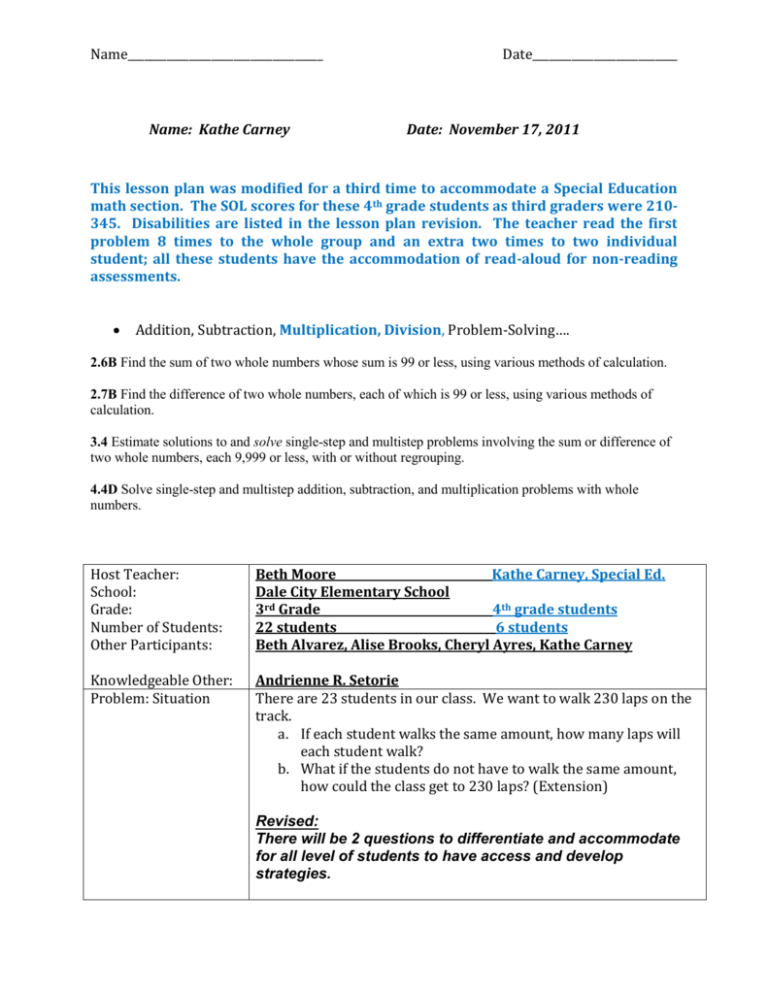
Name___________________________________ Name: Kathe Carney Date__________________________ Date: November 17, 2011 This lesson plan was modified for a third time to accommodate a Special Education math section. The SOL scores for these 4th grade students as third graders were 210345. Disabilities are listed in the lesson plan revision. The teacher read the first problem 8 times to the whole group and an extra two times to two individual student; all these students have the accommodation of read-aloud for non-reading assessments. Addition, Subtraction, Multiplication, Division, Problem-Solving…. 2.6B Find the sum of two whole numbers whose sum is 99 or less, using various methods of calculation. 2.7B Find the difference of two whole numbers, each of which is 99 or less, using various methods of calculation. 3.4 Estimate solutions to and solve single-step and multistep problems involving the sum or difference of two whole numbers, each 9,999 or less, with or without regrouping. 4.4D Solve single-step and multistep addition, subtraction, and multiplication problems with whole numbers. Host Teacher: School: Grade: Number of Students: Other Participants: Beth Moore Kathe Carney, Special Ed. Dale City Elementary School 3rd Grade 4th grade students 22 students 6 students Beth Alvarez, Alise Brooks, Cheryl Ayres, Kathe Carney Knowledgeable Other: Problem: Situation Andrienne R. Setorie There are 23 students in our class. We want to walk 230 laps on the track. a. If each student walks the same amount, how many laps will each student walk? b. What if the students do not have to walk the same amount, how could the class get to 230 laps? (Extension) Revised: There will be 2 questions to differentiate and accommodate for all level of students to have access and develop strategies. Name___________________________________ Identify the mathematical goals of the lesson, both short term and long term. Date__________________________ There are 6 students who want to walk a total of 96 laps. If each person wants to walk the same number of laps, how many laps will each student walk? Include an equation and show your work. This problem fit my class. It was given to the students during the 65 minute Special Education math instructional period. They worked on this problem on 11/16/11. There are 6 students who want to walk a total of 42 laps. If each person walks the same number of laps, how many laps will each student walk? Include an equation and show your work. This problem was given as a follow up on 11/17/11along with the exit question to determine if the students had generalized any of their strategies; generalization of information and strategies is a major problem with interventions provided to students with Special Needs. Short Term: Students will be able to demonstrate an understanding of word problems and will effectively use one strategy to solve a word problem. 3.4 Solve single-step and multistep problems involving the sum or difference of two whole numbers, each 9,999 or less, with or without regrouping. Identify the ways in which the task can be solved. Which of these methods do you think your students will use? What misconceptions might students encounter? What errors might a student make? Long term: Students will be able to develop more than one strategy to problem solve. Students will be able to differentiate between strategies that are more efficient than others. Students will be able to select the most appropriate strategy for a particular problem. Parceling out-using manipulatives Materials: Students may start counting by ones 200’s chart Students may use the base ten cm cubes Use the 300 hundreds chart to solve number line Picture representation snap together cubes Count by 23s picture representation Decompose and recombine…Count by 20s and add on 3s Use the hundreds chart to solve. extra paper Count by 6s. calculator for one Count by 7s. student who has the Use the hundreds board to look for patterns. accommodation Skip counting. calculator on her IEP Name___________________________________ Date__________________________ Misconceptions: Students may think that all 23 students need to walk 230 miles each. In the first lesson, students only counted by 10s. They did not count by 23s. Students may think that all 6 students need to walk 96 miles each. Unsure of what manipulative to use Even with rewording of the problem and visual supports, some students thought that each student would walk 96 miles Most could not see counting by anything but ones; one counted by two’s and one counted by five’s then switched to one’s Errors: Miscounting. Students may add the 230, 23 times. Students may add the 230 + 23. Miscalculation in adding, place value Students may add 96 + 6. Students may add 96, six times. Some students may not comprehend the story problem. Students might use the tools incorrectly. Students might not be able to find their answers on the representations-number lines, hundreds chart, or pictures. Miscounting Launch: How will you Mesmerized by the manipulatives (used as play things) introduce students to No adding displayed the task so as not to Launch reduce the problem Read the problem aloud to students. solving aspects of the task(s)? Teacher states that the total number of laps is 230 laps. What will you hear that Teacher defines lap. lets you know students Teacher provides a separate paper with each question understand the already at the top of the paper task(s)? Teacher provides a visual demonstration showing the 23 students at the starting line. Students retell the story/students repeat the directions to each other- Think/Pair/Share. Explore: As students Revised: are working Teacher introduces the problem and shows a tally independently or in mark as she demonstrates that each person runs a small groups: lap. What questions will Teacher shows 2 rounds per student for a total of 12. you ask to focus their Students work in pairs. thinking? Students will work in small-groups of three at two separate What will you see or tables. hear that lets you Name___________________________________ know how students are thinking about the mathematical ideas? What questions will you ask to assess students’ understanding of key mathematical ideas, problem solving strategies, or their representations? What questions will you ask to advance students’ understanding of the mathematical ideas? What questions will you ask to encourage students to share their thinking with others or to assess their understanding of their peers’ ideas? Which solution paths do you anticipate will come up and which do you want to have shared during the class discussion in order to accomplish the goals for the lesson? Which will be shared first, second, etc.? Why? In what ways will the order of the solution paths helps students make connections between the strategies and mathematical ideas? Date__________________________ The teacher read the problem 8 times to the groups; she demonstrated around the track with a print out of a track and various photos of teams. There was a track displayed on the computer screen throughout the problem solving session. (No smart board is available to Special Education.) Due to weak social skills and poorly developed verbal skills (communication and ESOL), the teacher asked leading questions of each group the first day. The second day (except for one student), the teacher did not need to ask leading questions. Exploration: How do you know to add 23? I’m wondering why you need to do this/that? Is there another way that someone can share with me? How do you know that? Does everyone agree with…? Does anyone want to add to that? So your saying that… What pattern do you notice? What strategy are you using? Is there a faster/more efficient way to solve this problem? Above questions used; rereading done of the problem eight times to the group; two more times to two individuals. Revised: How do you now to add 6/7? Evidence: We will see students actively using the mathematical tools We will see students recording information on their own papers We will see students recording information on their group charts. We will hear students talking to each other. Due to their disabilities and areas of weakness: Emotional Disabilities, Learning Disabilities; Oppositional Defiance, Socially Maladjusted, Speech and Language Disorders, Selective Mutism, ESOL, and lower level cognitive abilities, conversation between students at tables was limited. Leading questions were used by the teacher to elicit responses and conversation between team members. Assessment: What if we added one more student? What would happen? Does anyone have any other thoughts or comments about what we are talking about? Solution: Most concrete to the most abstract/Less efficient to more efficient strategy… Name___________________________________ Date__________________________ Assessment was not given after the first problem; the concept was too abstract for most of these students. The second problem was used as an Assessment. 1.) Base Ten Picture Representation 2.) Hundreds chart representation 3.) Repeated Addition representation Number Line Representation 4.) Number Line Representation 5.) Multiplication Representation What will you see or hear that lets you know that students in the class understand the mathematical ideas of problem solving strategies that are being shared? Students will make connections between the different representations. Students will relate strategies to each other. Students will be able to explain each other’s strategies. Students will complete an independent exit question: (Show your answer using 3 different strategies and circle the one that is the easiest for you.) After school 4 students decide to walk 20 laps on the track. a. If each student walks the same amount, how many laps will each student walk? Revised: Four students walked a total of 48 laps. Each student had to walk the same number of laps, how many laps did each student walk? Exit question was used as a ticket to Encore. The students who were successful with the first two problems commented that this was easy and finished the task speedily. The two students who were unable to complete the two problems did not have time to get to the Exit question. Since we are learning multiplication, several students wrote the multiplication algorithm as a solution. I only required one strategy. Name___________________________________ Date__________________________ There are 23 students in our class. We want to walk 230 laps on the track. If each student walks the same amount, how many laps will each student walk? (original question) Name___________________________________ Date__________________________ What if the students do not have to walk the same amount, how could the class get to 230 laps? (Extension Activity) The Extension Activity was not presented; the original questions were enough of a challenge. Name___________________________________ Date__________________________ EXIT CARD: (Show your answer using 3 different strategies and circle the one that is the easiest for you.) After school 4 students decide to walk 20 laps on the track. If each student walks the same amount, how many laps will each student walk? Only one strategy was required. Name___________________________________ Date__________________________ There are 6 students who want to walk a total of 96 laps. If each person wants to walk the same number of laps, how many laps will each student walk? Include an equation and show your work. This problem was used as the original question. Name___________________________________ Date__________________________ EXIT CARD: (Show your answer using 3 different strategies and circle the one that is the easiest for you. Include an equation.) There are 6 students who want to walk a total of 42 laps. If each person walks the same number of laps, how many laps will each student walk? This question was used the second day to determine if the students could generalize the strategies and discussions from the previous day to a similar problem. I only required one strategy from my students.
